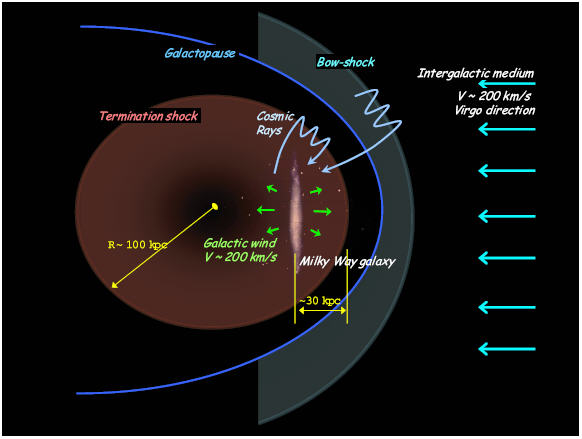Every 62 million years there is a mass extinction on Earth. No one is sure why but, since the solar motion through the Milky Way has been computed for the past 600 million years, we know it is too long a cycle for it to be a product of our solar system. A new paper theorizes this is because the earth begins to ... wobble ... due to solar oscillations and that wobbling happens on a predictable timetable.
They call it galactic shock due to cosmic ray modulation and its presence at those times impacts biological diversity - that means extinction and origination. The physicists, Mikhail V. Medvedev and Adrian L. Melott of the University of Kansas, say this has happened for the last half billion years. How much impact? As much as 10% of life on earth.
Why a wobble? Our sun is not alone in the universe, it travels on a galactic course and, the authors state, the point where it reaches its nearest orbit to other Milky Way stars, it's influenced by galaxies in the constellation Virgo.

bow shocks being sources of extragalactic cosmic rays. Due to inherent asymmetry, the north side of the Milky Way (with Virgo cluster being nearly at the north galactic pole)
is exposed to a larger cosmic ray flux than its south side.
So every 62 million years these gaseous interactions and the blending of radiation and magnetic fields from other galaxies send these oscillations through our solar system.
How do cosmic rays accomplish all this, and more importantly, how do they accomplish "extinction strength" drops in diversity or even mutations that bring about new life?
They do it in direct fashion, through radiation in the form of muons. We're all getting cosmic rays every day - up to 40% of the natural radiation we receive comes from cosmic rays - but these increased strength cosmic rays produce an avalanche of secondary energetic particles, muons, and what they don't kill, they damage or even mutate, including at deep sea levels.
Cosmic rays also impact climate change. Ions produced by cosmic rays increase clouds and that increases cooling.
The third effect is chemical. Increased ionization means more lightning and that means a change in ozone production and destruction by lightning-produced NOx.
Added to that, when NOx damages the solar shield it allows in more solar radiation, which can kill phytoplankton ( and a whole lot more marine life ) and cause its own mutations and cancer.
Is this fact? No, but it will be food for thought in the astrobiology community. If 'galactic shock' can cause periodic death it can also create periodic life.
Source: Do extragalactic cosmic rays induce cycles in fossil diversity?, Mikhail V. Medvedev and Adrian L. Melott, Astrophysical Journal, August, 2007




Comments